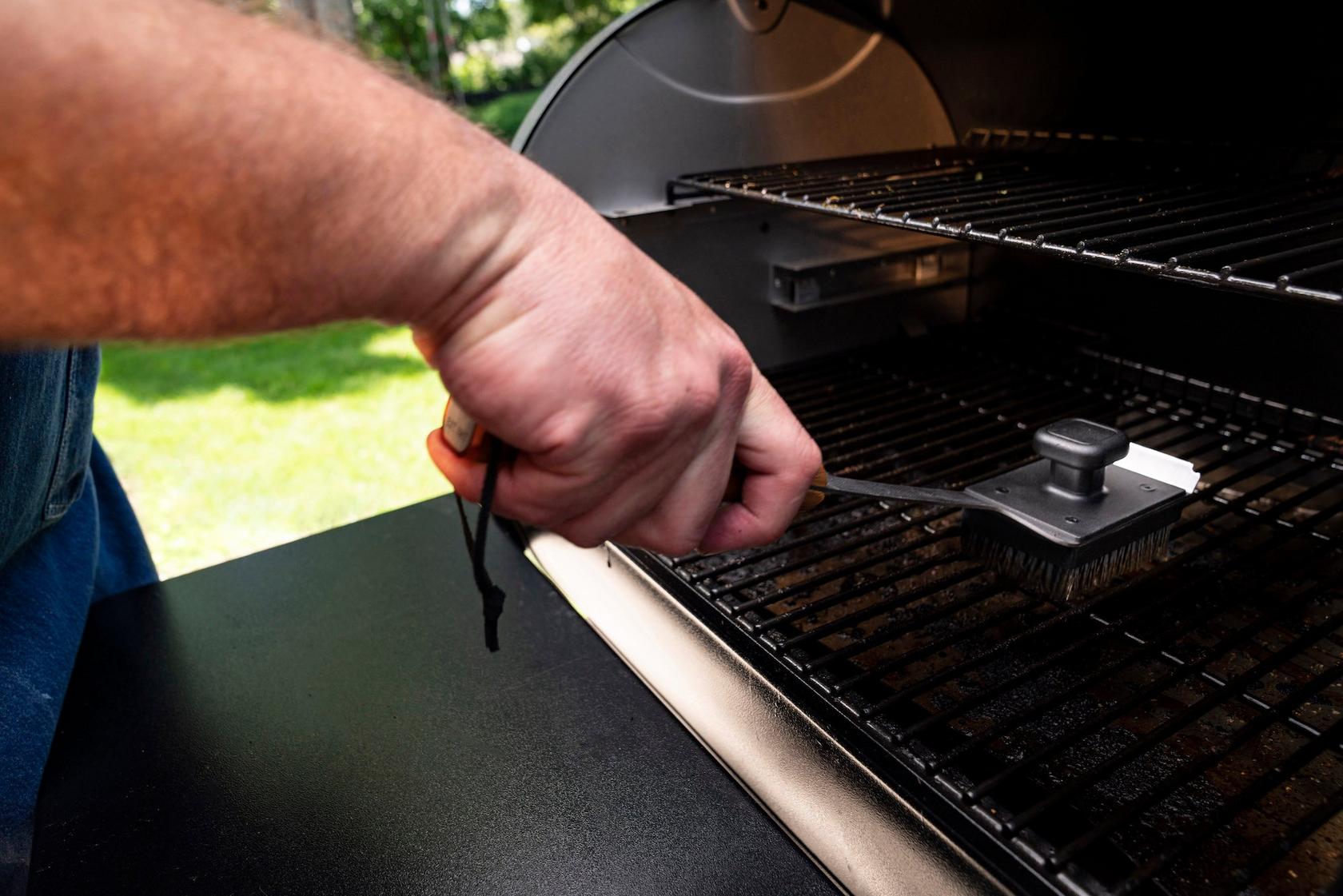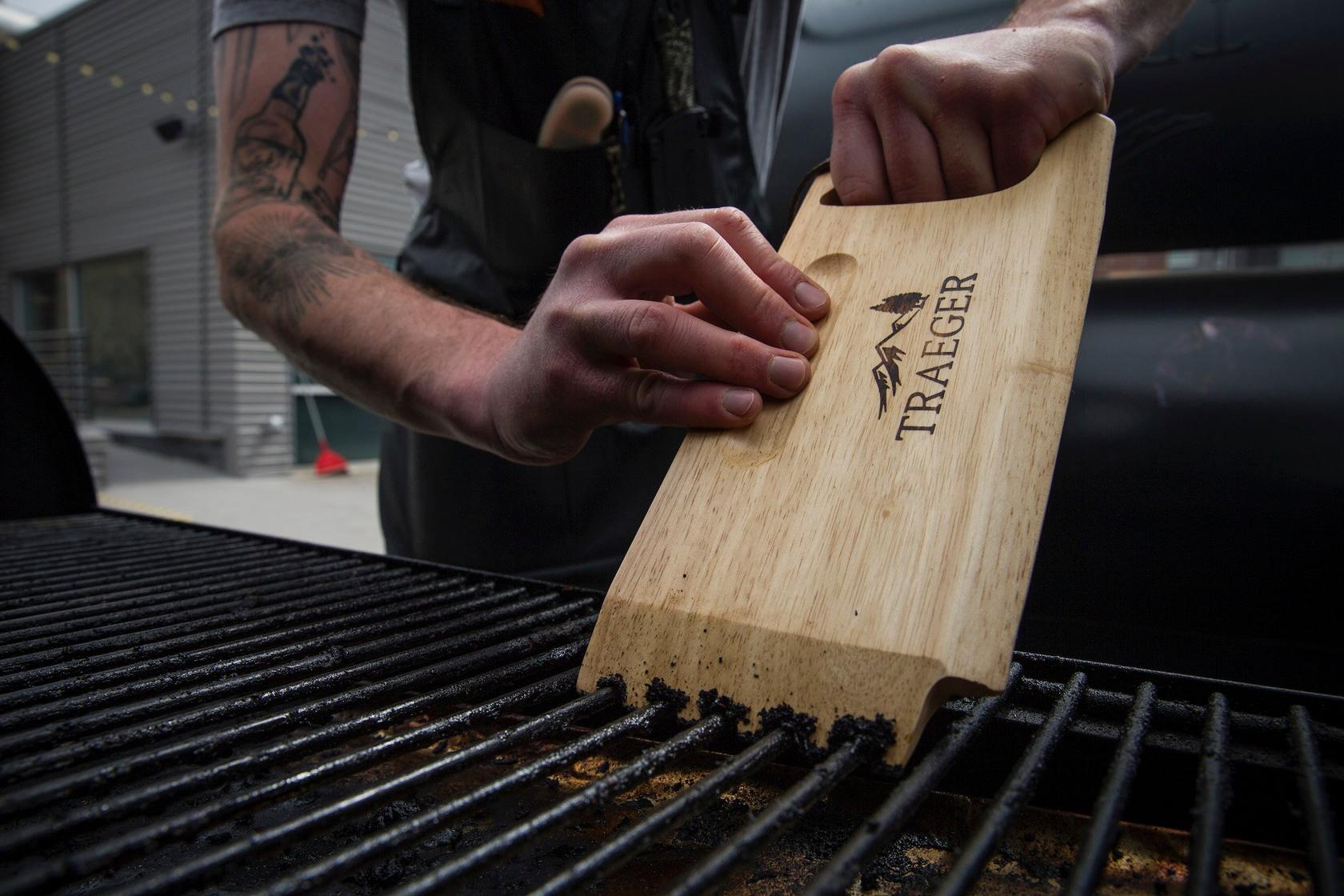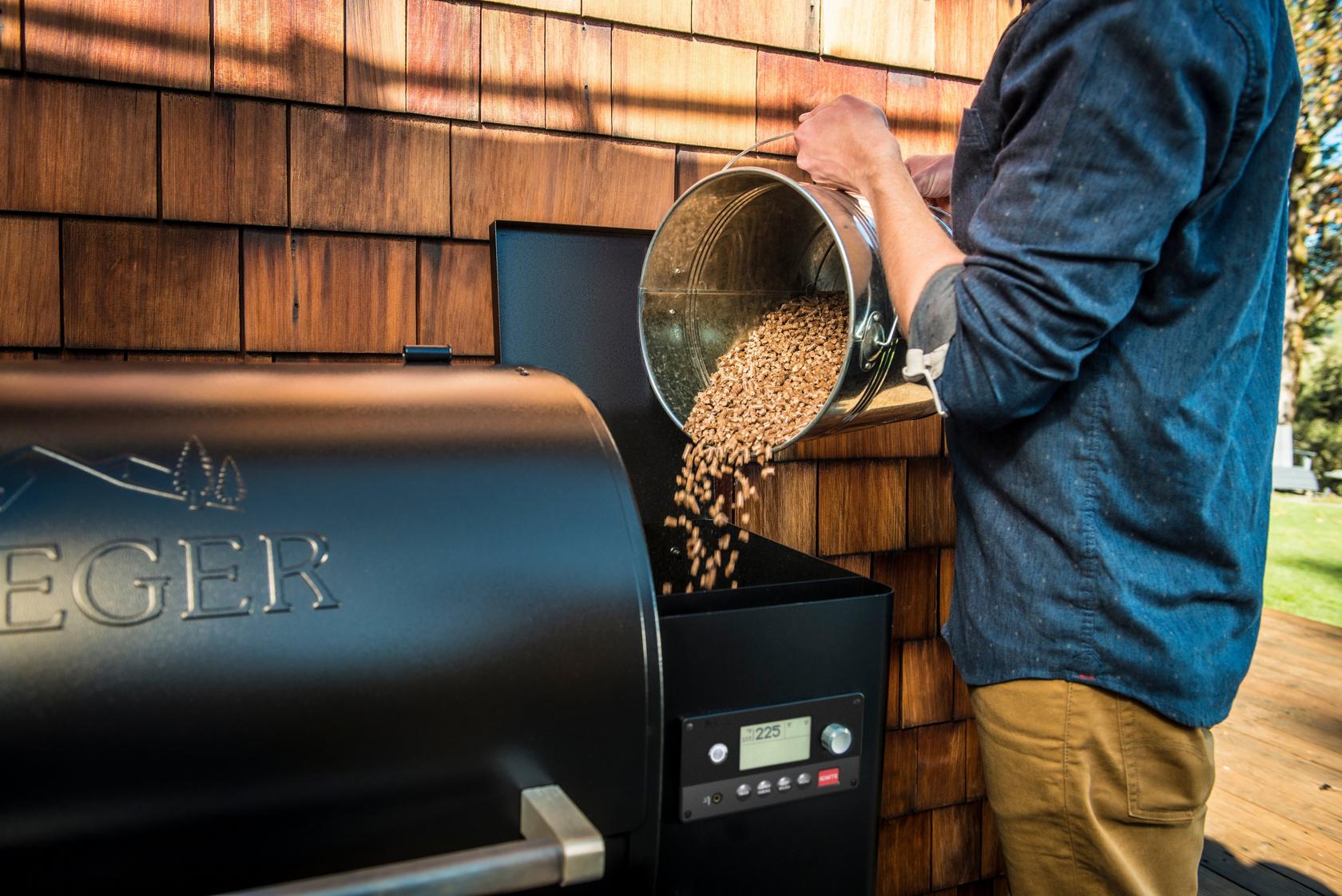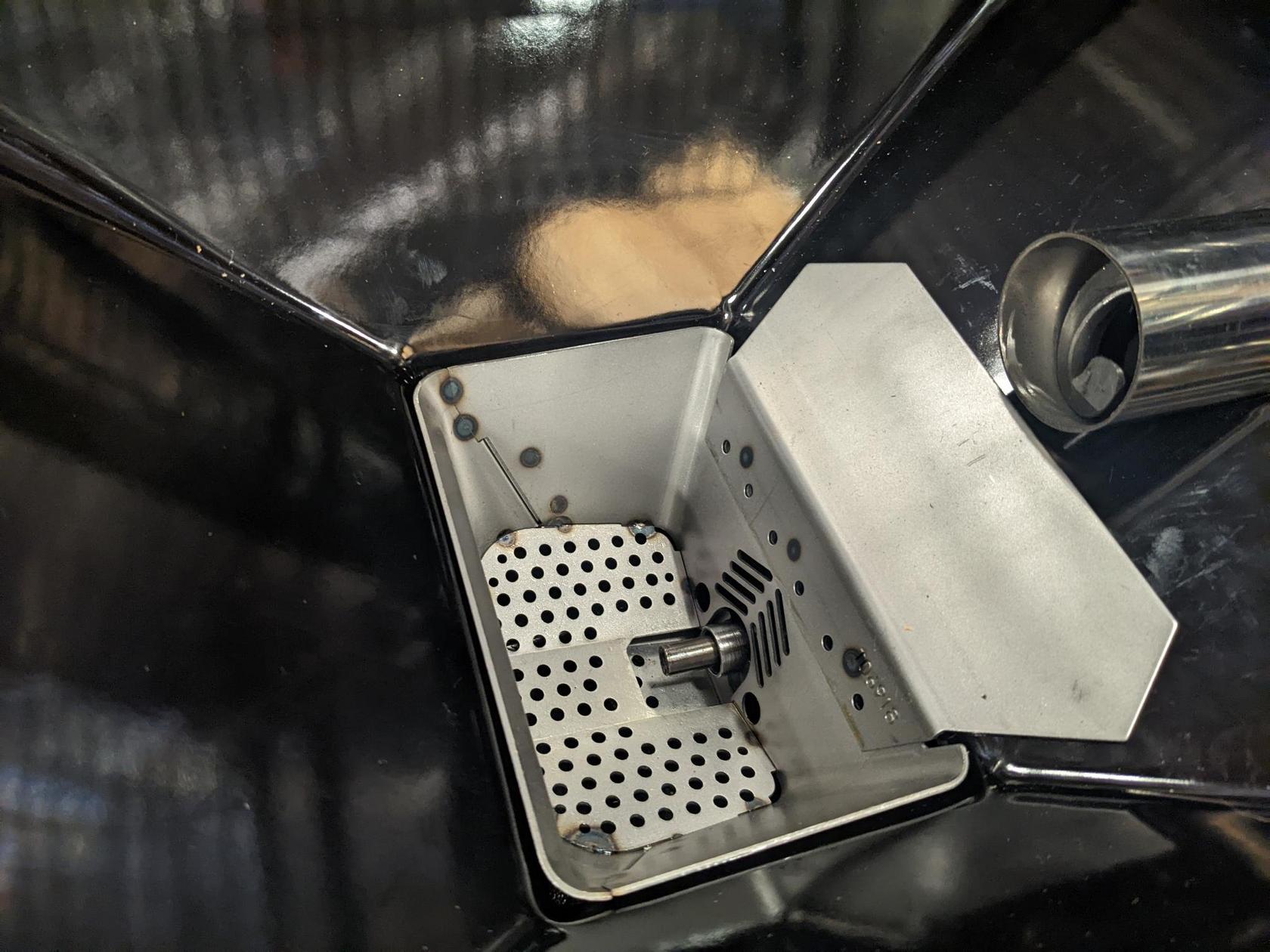
Sure, you're already dreaming of sizzling steaks and perfectly charred veggies on your new grill. But before you fire it up, there's one essential step you can't afford to overlook: maintenance.
Discover the key to preserving your Traeger Grill's performance and longevity by learning how to clean a Traeger Grill so that every cookout is a sizzling success.
Grill Care 101: How to Clean Your Traeger Grill with Ease
While the exact details for cleaning your grill may vary by type of grill, the basics remain the same.
- Make sure your grill is completely cool.
- Spray the grill grate and the inside of the chimney (if your grill has one) with an all-natural degreaser/cleaner (avoid the stress of looking for a cleaner and go with ours).
- Remove and clean both sides of the grill grates (keep reading to know how)
- If your grill uses a liner, dispose of old foil or drip tray liners.
- Remove the drip tray and the heat baffle.
- Empty the pellets from the hopper.
- Vacuum the inside of the grill, the firepot, and the hopper thoroughly, making sure you collect as much residual sawdust as possible.
- Scrub the inside of the chimney. Again, we recommend not using wire brushes. Instead, use a cleaning cloth or heavy-duty paper towels.
- Spray the inside and outside of the grill with the all-natural degreaser/cleaner and allow it to soak for several minutes before wiping it clean with a paper towel or cleaning cloth. While we recommend our Traeger All Natural Cleaner, you may also use any non-chemical cleaner or a mixture of diluted dish soap, water, and vinegar.
- Last, reinsert all components, including the heat baffle, drip tray, drip tray liners/foil, new bucket liners, and grill grates, and you are set!
For any lingering questions, make sure to check out Traeger Support.
How To Clean Grill Grates

Let’s get into the nitty-gritty of cleaning your grill grates. While it might seem like a daunting task, it doesn’t need to be.
- Ensure your grill has cooled down before beginning the cleaning process. However, if you find that the grates are still slightly warm, starting the scraping process at this point can make it easier.
- We strongly recommend NOT using wire brushes, but rather using a cleaning cloth, heavy-duty paper towels, or Traeger’s Nylon Cleaning Brush. If you choose to go with a wire brush, keep in mind that it will damage the ceramic coating on your grill grates and cause issues with your warranty.
- Depending on your grill type, you can also use the Traeger Wooden Grill Scrape. This safe alternative to a wire brush has been designed to fit into the grooves of your grill. However, if you have the new Timberline, Timberline XL, Ironwood, or Ironwood XL this product is not compatible.
Pro Tip: You can also use common household items to clean your grill if you don’t have a degreaser at home. Distilled white vinegar, onion, lemon, and baking soda & vinegar will get the job done as well.
How to Clean the Hopper, Fire Pot, and Grease Channels
Maintaining your Traeger isn't just about keeping the cooking surfaces clean; it's also crucial to pay attention to often-overlooked components like the hopper, fire pot, and grease channels. These three elements play a vital role in ensuring the performance, safety, and longevity of your grill.
Hopper

Unlocking the secret to unbeatable wood-fired flavor is understanding the crucial role of fresh wood pellets in the Traeger. Follow these steps to switch out and clean your hopper:
- Turn off and unplug your Traeger.
- Remove any remaining wood pellets from the hopper by vacuuming or scooping them out (for the Pro Series and new grills, you will be able to simply open the hopper cleanout door, and pour out the pellets).
- Use a shop vac to remove to remove residual sawdust and ash from the barrel. Make sure to look underneath the firepot and bottom of the hopper. For the AC or D2 WiFIRE Grill, make sure to also check the auger tube for sawdust.
- Inspect the hopper for any signs of moisture or mold buildup and wipe it clean with a dry cloth or paper towel.
Firepot

A dedicated vacuum cleaner is the best way to remove ashes from the firepot, but this must be done with extreme care to avoid the risk of fire. Make sure your grill is COLD when cleaning the ash from in and around the firepot.
Pro Tip: When you put the firepot back into its cavity, make sure the firepot lip does not get caught on the auger tube. The lip should sit flush with the grill cavity.
Grease
When cooking delicious food, grease is bound to accumulate. Not only will you want to check the inside of your grill for grease buildup, but if you have a Pro Series grill, you will also want to check the chimney. For grills without a chimney, double-check the backpack/downdraft.
For owners of the new Timberline and Ironwood Grills, make sure to clean grease from the Grease Governor (cap), Grease Tube, and Grease & Ash Keg.
When it comes to grills like the Traeger Woodridge Grills (Woodridge, Woodridge Pro, and Woodridge Elite) cleaning any grease or ash out is easy and hassle-free. Other than general maintenance as we listed above, simply empty out the EZ-Clean Grease & Ash Keg and replace. No need for a shop vac with this grill.
For additional resources with step-by-step instructions, check out the following pages:
How To Clean A Flatrock Grill
If you love griddling, frying, steaming, sautéing, and more, you’ll need to know how to clean the Flatrock Grill when asking yourself how to clean a Traeger Grill. To maintain a working flat top grill, clean the following grill parts every cook to maintain a non-stick surface and to prevent rust:
- Cooktop
- Burners
- Grease Chute
- Grease Keg Liner
When cleaning these surfaces, ensure you have the following items: a clean cloth or paper towels, Traeger All Natural Cleaner or another all-natural, non-chemical cleaner, water, a Flat Top Grill Essentials Kit, and a Traeger Flat Top Grill Seasoning & Cast Iron Conditioner (canola oil will also work in a pinch).
Make sure to follow the steps in this article to learn how to best clean your Flat Rock, and then learn the difference between a griddle vs. grill, and the best griddle foods to cook for your next feast.
When To Clean Your Grill
Now that you know how to clean a Traeger grill, you need to know when you should clean your grill. While you should follow the recommended schedule below, remember that you may need to adjust according to your cooking habits and food smoking preferences. For example, if you’re cooking high-fat foods like pork belly or brisket, your grill will require cleaning sooner than veggies or breads.
- After Each Use: Wipe down spills and scrape down the grill grates.
- Every 2-3 Cooks (or every 20-24 hours of cook time): Deep clean the inside of the grill.
- Every 3 Months: Clean the outside of the grill (especially if you don’t have a grill cover)
- Every 6 Months: Clean the grease chute (or the backpack/downdraft if the grill does not have a chimney) to avoid grease fires.
How To Clean a Traeger Grill FAQs
How Do I Prevent Rust?
The simple answer? Regular cleaning and maintenance. While Traeger Grill’s are made with powder-coating on the grates to prevent rust, it’s always good practice to keep the grates clean. You will also want to keep your grill clean and dry, remove excess grease and food particles, use rust-preventative products, and protect your grill from the elements. Read our article for more information.
What Cleaning Products Should I Use and Why?
Traeger Grill’s may be hardy, but you can’t just clean them with anything and hope for the best (especially if you want to protect your warranty). When you purchase your pellet grill, make sure to also invest in the following tools:
As a precaution (especially during busy grilling seasons when you’re likely to go through these products faster), make sure to have disposable cloths or heavy-duty towels on hand, along with distilled white vinegar, onion, lemon, baking soda & vinegar, and dish soap. These common household items will help keep your grill smoking like normal.
How Do I Know When to Clean My Grill?
While you should always keep the recommended schedule above in mind, there are a few indicators to keep an eye out for:
- If you see build-up on the drip rail or grates
- When the foil starts to look overly greasy
- If you’re not able to maintain your cooking temperature
For those Traeger owners that have a WiFIRE grill, you will get a “Clean Grill” notification every 35 cooks.
Do I need a Drip Tray Liner?
Each Traeger grill model is fitted with a drip tray specific to the grill's shape, size, and features. To find which drip tray is compatible with your grill, look at the Replacement Parts list found in your grill's Support Guide.